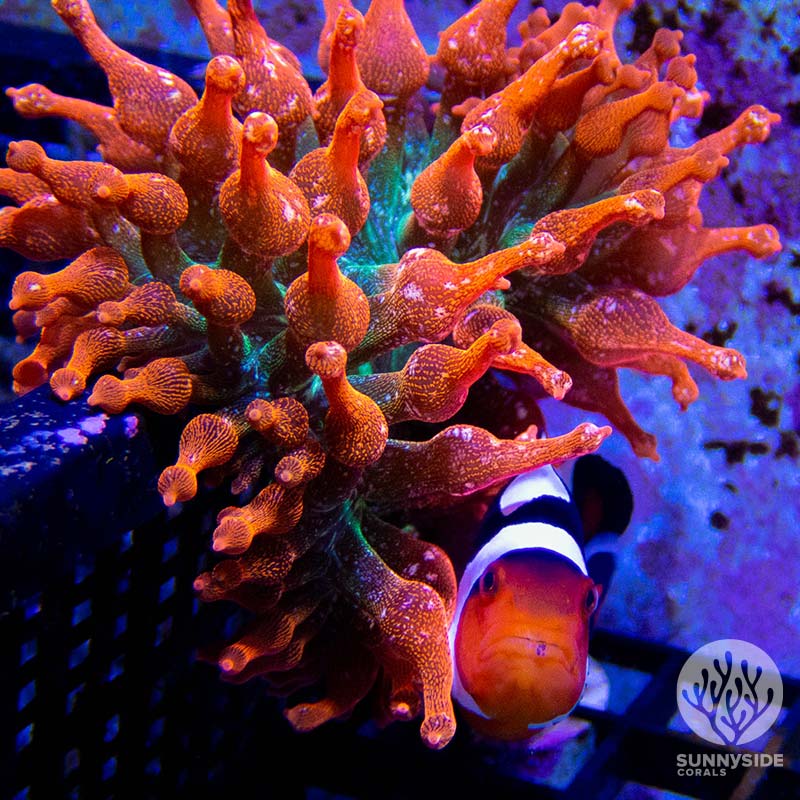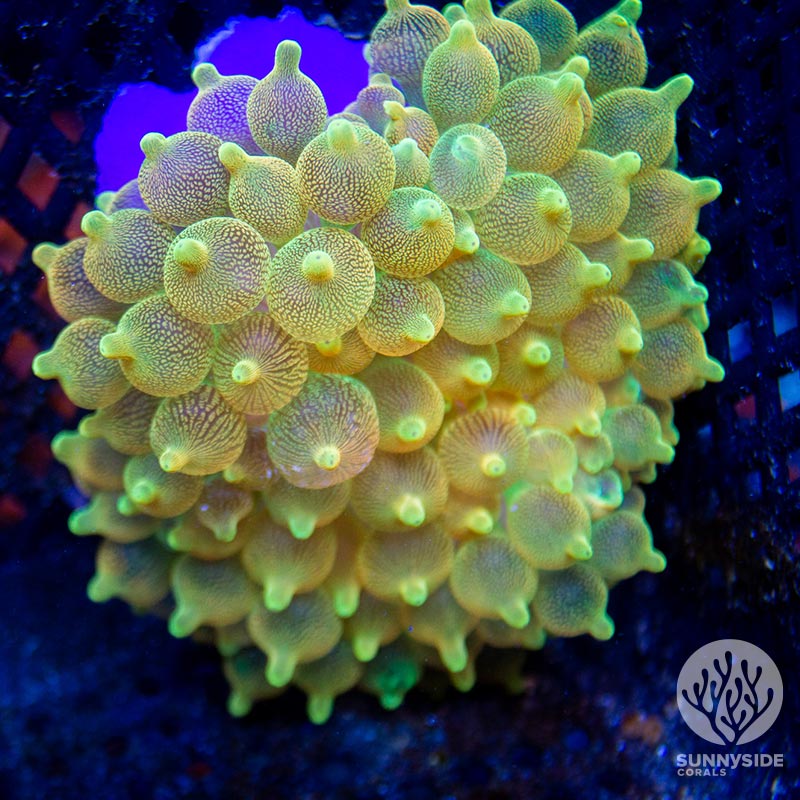As aquarium enthusiasts, we are always looking for ways to create a beautiful and healthy environment for our fish. One of the most fascinating relationships in the aquarium world is the symbiotic relationship between anemones and clownfish. These fish are known for their unique ability to live among the stinging tentacles of anemones without being harmed.
Clownfish and anemones have a mutualistic relationship, meaning they both benefit from living together. The anemone provides protection for the clownfish by stinging potential predators, while the clownfish provides the anemone with food scraps and helps to circulate the water around it. However, not all clownfish species will naturally host with anemones, and it can take time and patience to establish this relationship in your aquarium.


Anemone Hosting Clownfish: A Symbiotic Relationship
When we think of the ocean, we often picture colorful coral reefs with a diverse array of sea creatures. One of the most iconic relationships found in these reefs is the symbiotic relationship between anemones and clownfish. In this section, we will explore what anemones and clownfish are, and how they form this unique and beneficial relationship.
What is an Anemone?
Anemones are marine animals that belong to the phylum Cnidaria, which also includes corals, jellyfish, and hydroids. They are named after the terrestrial flower because of their colorful appearance and petal-like tentacles. Anemones are sessile, meaning they are attached to a surface and cannot move around. They use their tentacles to capture prey, such as small fish and plankton, and can also defend themselves from predators with their stinging cells.
What is a Clownfish?
Clownfish, also known as anemonefish, are small, brightly colored fish that are found in the tropical waters of the Indian and Pacific Oceans. They are named for their playful and clown-like behavior, and are often associated with the anemones they live in. Clownfish have a special mucus layer on their skin that protects them from the anemone’s stinging cells, allowing them to live among the tentacles without being harmed. They are also immune to the toxins produced by the anemone, which makes them an ideal resident for the anemone.
The Symbiotic Relationship between Anemones and Clownfish
The symbiotic relationship between anemones and clownfish is a classic example of mutualism, where both species benefit from the interaction. The anemone provides the clownfish with protection and shelter from predators, as well as a place to lay their eggs. In return, the clownfish provide the anemone with nutrients in the form of waste, while also scaring off potential predator fish. This relationship is so important that some species of clownfish cannot survive without anemones.
It is important to note that not all anemones are suitable hosts for clownfish. Different species of anemones have different requirements for their environment, and not all anemones produce the same toxins that clownfish are immune to. This means that each species of clownfish has evolved to live with a specific species of anemone, and cannot survive with other species.
Overall, the symbiotic relationship between anemones and clownfish is a fascinating example of how different species can work together to survive and thrive in their environment. It is a reminder of the importance of biodiversity and the interconnectedness of all life on Earth.
Types of Anemones that Host Clownfish
When it comes to hosting clownfish, there are a few types of anemones that are the most popular. In this section, we will discuss the Bubble Tip Anemone, Magnificent Sea Anemone, and Giant Carpet Anemone.
Bubble Tip Anemone
The Bubble Tip Anemone, also known as Entacmaea quadricolor, is one of the most popular anemones for clownfish. They are relatively easy to care for and come in a variety of colors, making them a great addition to any saltwater aquarium. They are known for their bubble-like tips, which are usually a different color than the rest of the anemone. Clownfish will often host in the bubbles of the anemone, creating a beautiful symbiotic relationship.
However, it is important to note that not all clownfish will host in Bubble Tip Anemones. Some species, such as the Tomato Clownfish, are not known for hosting in any type of anemone. It is important to research the specific species of clownfish you plan to keep to ensure they will be compatible with the anemone you choose.
Magnificent Sea Anemone
The Magnificent Sea Anemone, also known as Heteractis magnifica, is another popular choice for clownfish. They are known for their bright colors and long tentacles, which can reach up to a foot long. Clownfish will often host in the tentacles of the Magnificent Sea Anemone, creating a stunning display in your aquarium.
However, it is important to note that the Magnificent Sea Anemone can be more difficult to care for than other types of anemones. They require high levels of light and strong water flow, as well as regular feeding. If you are a beginner aquarist, it may be best to start with a different type of anemone before attempting to care for a Magnificent Sea Anemone.
Giant Carpet Anemone
The Giant Carpet Anemone, also known as Stichodactyla gigantea, is one of the largest anemones that can host clownfish. They can grow up to three feet in diameter and come in a variety of colors, including green, purple, and brown. Clownfish will often host in the center of the Giant Carpet Anemone, creating a stunning display in your aquarium.
However, it is important to note that the Giant Carpet Anemone can be more difficult to care for than other types of anemones. They require high levels of light and strong water flow, as well as regular feeding. They can also be aggressive towards other fish and invertebrates in your aquarium, so it is important to research their compatibility before adding them to your tank.
How Do Anemone Hosting Clownfish Benefit Each Other?
Protection from Predators
When a clownfish decides to make an anemone its home, it receives protection from predators. The anemone’s tentacles provide a safe haven for the clownfish to hide in, and the clownfish helps to protect the anemone from butterfly fish that would eat the anemone. This mutual relationship benefits both the clownfish and the anemone, as the clownfish receives a safe home, and the anemone receives protection from predators.
Food and Nutrients
Clownfish also benefit anemones by providing them with food and nutrients. Clownfish produce waste that anemones can use as a source of nutrients. The clownfish also helps to attract larger or smaller fish by their colorful orange and white bodies that the anemone can eat. This mutually beneficial relationship ensures that both the clownfish and the anemone have access to the nutrients they need to thrive.
Anemone Cleaning and Care
In addition to providing food and protection, clownfish also help to keep the anemone clean and healthy. Clownfish are known to clean the anemone by removing parasites and dead tissue from the anemone’s surface. This cleaning process helps to keep the anemone healthy and free from disease. Additionally, clownfish help to oxygenate the tentacles of the anemone as they swim through it, which helps to keep the anemone healthy and thriving.
Overall, the relationship between anemone hosting clownfish is a perfect example of mutualism in nature. Both the clownfish and the anemone benefit from their relationship, and they have evolved to rely on each other for survival. As we continue to study and learn more about this fascinating relationship, we can gain a greater appreciation for the complex and interconnected nature of the natural world.
FAQ’s
Why do anemones host clownfish?
Clownfish and anemones have a symbiotic relationship. Anemones provide protection for clownfish from predators, while clownfish provide food for anemones. The mucus on the clownfish’s skin also protects the anemone from parasites and other harmful organisms.
How long does it take clownfish to host anemone?
The time it takes for clownfish to host anemones varies depending on the species and the individual fish. Some clownfish may host anemones within a few days, while others may take several months. It’s important to be patient and give the fish time to adjust to their new environment.
Can a clownfish over host an anemone?
Yes, it is possible for a clownfish to over host an anemone. This can lead to the anemone becoming stressed and potentially dying. It’s important to monitor the behavior of both the clownfish and the anemone to ensure that they are both healthy and thriving.
Why won’t my clowns host my anemone?
There are several reasons why clownfish may not host anemones. One reason may be that the anemone is not the right species for the clownfish. Another reason may be that the clownfish are not comfortable in their environment and do not feel safe enough to host the anemone. It’s important to ensure that the aquarium environment is suitable for both the clownfish and the anemone.
